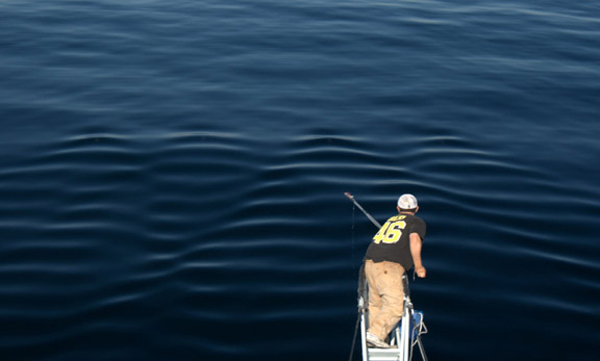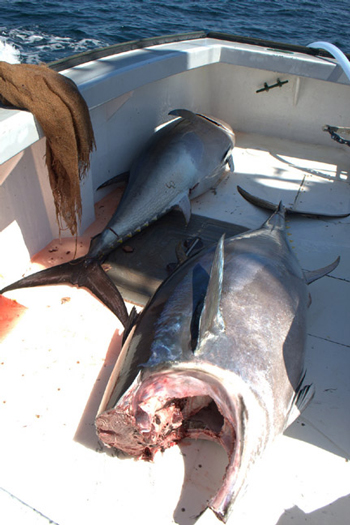C O M M E N T A R Y
Bluefin Season Strong in Spite of Hurdles
by Chris Weiner

Chris Weiner in the pulpit harpooning, going on a bunch of 4 fish, off Maine. Photo by Chris Weiner
The last two years have been as hectic for the U.S. bluefin fishery as any other two years in its history, an impressive feat given all that this fishery has faced in the past.
As Fishermen’s Voice readers will remember, in 2010 the U.S. fishery dodged a bullet when the proposal to list bluefin on CITES Appendix I was soundly defeated. But the feeling of relief was short lived.
Despite the fact that an overwhelmingly large majority of the 175 nations at CITES decided that bluefin were not “endangered,” the Center for Biological Diversity (CBD), an Arizona-based NGO, filed a petition to list bluefin on the U.S. Endangered Species Act (ESA) in May of 2010. Due to what many see as an inherent flaw in the ESA law, the government decided to move forward with a full status review for bluefin despite there being no science showing that CBD was making a valid claim. The decision was due by May 2011.
As the Endangered Species Act (ESA) status review was underway, the International Commission for the Conservation of Atlantic Tuna (ICCAT) met in mid-November in Paris to set quotas and other management measures for the coming years. Despite what many in the industry felt was a very positive stock assessment, NOAA, with the support of NGOs, led an effort to drastically reduce the western Atlantic quota for 2011. While the eventual quota cut was smaller than NOAA wanted, it was no doubt problematic given the already-low quotas in place and the fact that NOAA was planning to deduct pelagic longline (PLL) discard totals off the overall U.S. quota.
While the quota cut had caused great consternation among fishermen, all eyes were quickly refocused on the ESA status review. Many were concerned that somehow the ESA listing would go forward, which would have meant fishermen could not even “pursue” a bluefin, let alone catch and sell one. In May, NOAA eventually made the right decision and announced the listing was not warranted and a collective weight was lifted off the shoulders of those in the industry.
To say that it felt good for fishermen from Maine to New Jersey to finally head out on June 1 to begin fishing this season would be an understatement. Even without the joy felt in the wake of the ESA decision, most fishermen were anxious to start the 2011 season. While some lean years had been seen in the mid-2000s as a result of a lack of herring to attract and hold bluefin in our waters, new rules on the herring fleet have allowed the bluefin fishery to start to rebuild in recent years. While significant improvements were seen in 2009, the 2010 season was even better.

An 88 inch and an 82 inch bluefin tuna aboard Chris Weiner's boat that were caught off southern Maine. Photo by Chris Weiner
It did not take long for the 2011 season to get going. Within the first week of the season, harpooners off Maine were already catching fish; a week or two later the harpooners in Massachusetts began catching fish as well. While the fish were spread out along the entire coast from eastern Maine to Cape Cod, there were a handful of areas that remained consistent for most of June and July. As is usually the case with bluefin, these were the areas near the largest aggregations of bait.
While the harpoon fishery has been doing well in recent years, this season there were not only a lot of fish caught but the prices were much higher. It was not out of the ordinary for fish to bring $20 or more per pound. Due to the large numbers of fish, the harpoon category was on pace to catch its quota by mid-August when it was all but shut down when the weather took a turn for the worse and it has remained terrible ever since.
As usual, the hook fishery started a bit slower than the harpoon fishery this season. But before long there were fish being taken from a number of areas off Maine, New Hampshire, and Massachusetts. As has been the case in recent years, most boats were using live bait to avoid being harassed by dogfish, a less effective method than the traditional method of chumming.
Hook landings were pretty consistent inshore for the first three months, but it was not long before fishermen began thinking of striking off to Georges Bank to find the greatest number of fish. In what has been a clear sign of the lack of bait inshore, the largest amount of bluefin in recent years have been seen just miles from the Canadian line, on the far reaches of the Northern Edge. In 2010 the fishing had been phenomenal on Georges, with boats hand-feeding bluefin at times.
While many boats were picking away at the fish inshore, a group of boats began heading to Georges at the beginning of September and so far the fishing has been solid. Unlike last year, though, the herring pair trawl fleet had been working the area hard since May, taking in excess of 77 million pounds of herring by the end of September. As a result, fishing has not been as strong offshore this season. Whereas last year many boats were catching their three-fish limit quickly and heading back, there have been lots of reports of boats staying multiple days this season and not catching their limit. That said, the landings are strong enough that many believe the general category will have no problems catching its quota this season.
All in all, it has been a good season for the bluefin fishery and lots of fish have been seen and caught. While there continue to be concerns about the amount of bait around as well as the potential battles we will be facing down the road, most in the fishery are very optimistic about the future.
